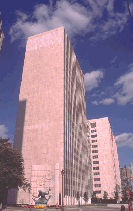Over the past decade there has been a spate of municipal amalgamations. This process of assembling a smaller number of larger municipalities from a larger number of smaller ones is generally favoured by provincial or state governments. This is largely because it leads to fewer entities with which the senior government has to do business.
Now we have a growing movement for municipal "de-amalgamation," reversing
the process by splitting apart the joined municipalities into their original
component jurisdictions. This process is favoured by citizens who
feel their autonomy and identity are submerged in the larger town or city.

Whatever the merits of either movement, the impact on address data
is significant. Consider all of the incidents of municipal addresses
within databases around the world. This core piece of information
is a vital linking and sorting mechanism for organizing and manipulating
data of all kinds.The municipality name is a fundamental component of
the address string. To change this core component has many ripple
effects.
Changing the municipality name itself within all of the databases in
which it resides is a major job. In some cases the same geographic
area has been amalgamated several times complicating things further.
Keeping track of historical names is therefore necessary to avoid data
loss. Amalgamation is substantially more complex than simply changing
a town name, because the geographic area covered (and the corresponding
address locations within this area) are not equivalent.

Street names are normally unique within municipalities. This
is vitally important because if the street name is not unique, the same
address can occur in more than one part of the same town. The resulting
confusion can lead to considerable time loss and frustration. For
emergency services, the minutes or seconds lost due to address ambiguity
can mean the difference between life and death.
Some streetnames are very common. Main Street, Second Street, Third Street, Park Street, King Street and Queen Street can be found in many towns. When municipalities amalgamate, formerly unique names become duplicated. This is normally resolved by renaming one or both of the original streets. While this officially solves the problem, unofficially many people will continue to use the old names. Any databases compiled before the official name change will bear the old names, and many addresses collected afterwards will still contain the old names. This means that data administrators need to be aware of and account for these ambiguities on an ongoing basis.
This issue also applies to address numbers. In many cases where a street continues through adjacent municipalities, the street name is the same in both towns, but the street numbering is independent. When these two towns amalgamate the same street number will occur in more than one place on the same street. Who said this stuff was easy?! Now everyone agrees on the street name, but at least one of the street numbers has to change. From a data administration point of view this is even more complex than the changing of the street name because there is often no context to indicate whether it's 21 Main Street, Mytown is the old 21 Main Street or the new 21 Main Street.
All of this has given rise to the science of Address Management - dedicated to resolving address ambiguity and maintaining accurate address databases over time. More on this in a future article. In the meanwhile, take municipal amalgamation (or deamalgamation) with a grain of salt and a couple of aspirin.